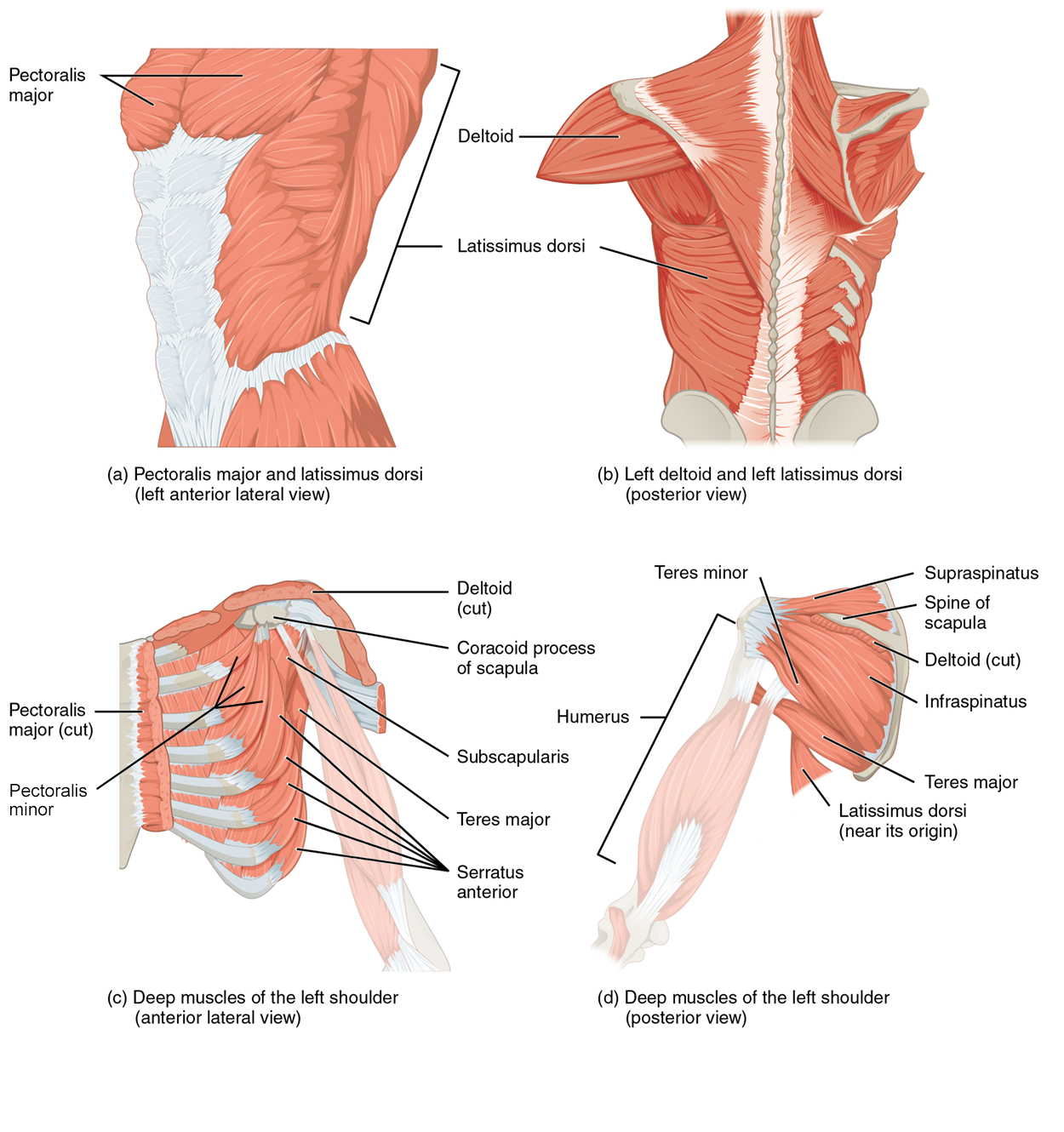Table of Contents |
Similar to the muscles that position the pectoral girdle, muscles that cross the shoulder joint and move the humerus bone of the arm include both axial and scapular muscles. The largest muscles are the pectoralis major and the latissimus dorsi. The pectoralis major (pectoralis, pectoral region; major, large) is thick and fan-shaped, covering much of the superior portion of the anterior thorax. This muscle flexes, adducts, and medially rotates the shoulder. The broad, triangular latissimus dorsi (latus, broad; dorsi, posterior) is located on the inferior part of the back and extends, adducts, and medially rotates the shoulder.
The rest of the shoulder muscles originate on the scapula. The anatomical structure of the shoulder joint and the arrangements of the muscles covering it allow the arm to carry out different types of movements. The deltoid (delta, triangular), the thick, triangular-shaped muscle that creates the rounded lines of the shoulder is the major abductor of the arm but it also facilitates flexing and medial rotation, as well as extension and lateral rotation. The subscapularis (sub, underneath; scapularis, scapula) originates on the anterior scapula and medially rotates the arm. Named for their locations, the supraspinatus (supra, superior; spinatus, spine of the scapula) abducts the shoulder while the infraspinatus (infra, inferior) laterally rotates the shoulder. The thick and flat teres major is inferior to the teres minor and extends the arm and assists in adduction and medial rotation of it. The long teres minor laterally rotates and extends the arm. Finally, the coracobrachialis (coraco, coracoid process of the scapula, brachialis, brachial region) flexes and adducts the arm.
The tendons of the subscapularis, supraspinatus, infraspinatus, and teres minor connect the scapula to the humerus, forming the rotator cuff (musculotendinous cuff), the circle of tendons around the shoulder joint. When baseball pitchers undergo shoulder surgery, it is usually on the rotator cuff, which becomes pinched and inflamed and may tear away from the bone due to the repetitive motion of bringing the arm overhead to throw a fast pitch.

| Muscle | Action | Origin | Insertion |
|---|---|---|---|
| Coracobrachialis (not shown in image) | Adducts and flexes the shoulder | Coracoid process of scapula | Shaft of humerus |
| Deltoid | Flexes, extends, medially and laterally rotates, and abducts the shoulder | Clavicle, acromion process of scapula | Deltoid tuberosity of humerus |
| Infraspinatus | Laterally rotates of shoulder | Infraspinous fossa of scapula | Greater tubercle of humerus |
| Latissimus Dorsi | Extends, adducts, and medially rotates the shoulder | Spinous process of T7–T12, iliac crest of ilium, ribs 9–12, inferior scapula | Intertubercular sulcus of humerus |
| Pectoralis Major | Flexes, adducts, and medially rotates the shoulder | Ribs 2–6, body of sternum, clavicle | Greater tubercle of humerus |
| Subscapularis | Medially rotates the shoulder | Subscapular fossa of scapula | Lesser tubercle of humerus |
| Supraspinatus | Abducts the shoulder | Supraspinous fossa of scapula | Greater tubercle of humerus |
| Teres Major | Extends and medially rotates the shoulder | Lateral border of scapula | Intertubercular sulcus of humerus |
| Teres Minor | Laterally rotates and adducts the shoulder | Lateral border of scapula | Greater tubercle of humerus |
IN CONTEXT
Career Connection: Physical Therapists
Those who have a muscle or joint injury will most likely be sent to a physical therapist (PT) after seeing their regular doctor. PTs have a master’s degree or doctorate and are highly trained experts in the mechanics of body movements. Many PTs also specialize in sports injuries.
If you injured your shoulder while you were kayaking, the first thing a physical therapist would do during your first visit is to assess the joint's functionality. The range of motion of a particular joint refers to the normal movements the joint performs. The PT will ask you to abduct and adduct, circumduct, and flex and extend the arm. The PT will note the shoulder’s degree of function and, based on the assessment of the injury, will create an appropriate physical therapy plan.
The first step in physical therapy will probably be applying a heat pack to the injured site, which acts much like a warm-up to draw blood to the area, to enhance healing. You will be instructed to do a series of exercises to continue the therapy at home, followed by icing, to decrease inflammation and swelling, which will continue for several weeks. When physical therapy is complete, the PT will do an exit exam and send a detailed report on the improved range of motion and return of normal limb function to your doctor. Gradually, as the injury heals, the shoulder will begin to function correctly. A PT works closely with patients to help them get back to their normal level of physical activity.
Source: THIS TUTORIAL HAS BEEN ADAPTED FROM OPENSTAX “ANATOMY AND PHYSIOLOGY 2E.” ACCESS FOR FREE AT HTTPS://OPENSTAX.ORG/DETAILS/BOOKS/ANATOMY-AND-PHYSIOLOGY-2E. LICENSE: CC ATTRIBUTION 4.0 INTERNATIONAL.